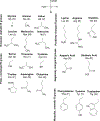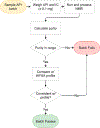Quality Control of Therapeutic Peptides by 1H NMR HiFSA Sequencing
- PMID: 30793905
- PMCID: PMC6452441
- DOI: 10.1021/acs.joc.8b02704
Quality Control of Therapeutic Peptides by 1H NMR HiFSA Sequencing
Abstract
Ensuring identity, purity, and reproducibility are equally essential during synthetic chemistry, drug discovery, and for pharmaceutical product safety. Many peptidic APIs are large molecules that require considerable effort for integrity assurance. This study builds on quantum mechanical 1H iterative Full Spin Analysis (HiFSA) to establish NMR peptide sequencing methodology that overcomes the intrinsic limitations of principal compendial methods in identifying small structural changes or minor impurities that affect effectiveness and safety. HiFSA sequencing yields definitive identity and purity information concurrently, allowing for API quality assurance and control (QA/QC). Achieving full peptide analysis via NMR building blocks, the process lends itself to both research and commercial applications as 1D 1H NMR (HNMR) is the most sensitive and basic NMR experiment. The generated HiFSA profiles are independent of instrument or software tools and work at any magnetic field strength. Pairing with absolute or 100% qHNMR enables quantification of mixtures and/or determination of peptide conformer populations. Demonstration of the methodology uses single amino acids (AAs) and peptides of increasing size, including the octapeptide, angiotensin II, and the nonapeptide, oxytocin. The feasibility of HiFSA coupled with automated NMR and qHNMR for use in QC/QA efforts is established through case-based examples and recommended procedures.
Conflict of interest statement
The authors declare the following competing financial interest(s): M.N. is the founder of NMR Solutions Ltd. The other authors declare no competing financial interest.
Figures








References
-
- Lau JL; Dunn MK Therapeutic peptides: Historical perspectives, current development trends, and future directions. Bioorg. Med. Chem 2018, 26, 2700. - PubMed
-
- Swietlow A; Lax R Quality control in peptide manufacturing: specifications for GMP peptides. Pept. Chem 2004, 7, 22–24.
Publication types
MeSH terms
Substances
Grants and funding
LinkOut - more resources
Full Text Sources
Other Literature Sources

